Food 3D printers print food pastes rather than plastic filaments, printing delicious chocolate, jam or toffee layer-by-layer to create a custom dessert or savory dish based on your design.
Want to 3D print a model of your face in chocolate? Or print your company’s brand in biscuit to send to potential clients?
Our ranking below features some of the best 3D printers for printing food, and compares them on accuracy, speed, variety of food types you can 3D printer, and more.
The Best Food 3D Printers in 2024
1. mycusini 2.0
- Price: Basic – $535 / Starter – $647 / Comfort – $699 / Premium – $805
- Build volume: 105 x 80 x 50 mm
- Print speed: 5 – 50 mm/s
- Food it can print: mycuisini 3D Choco cartridges only
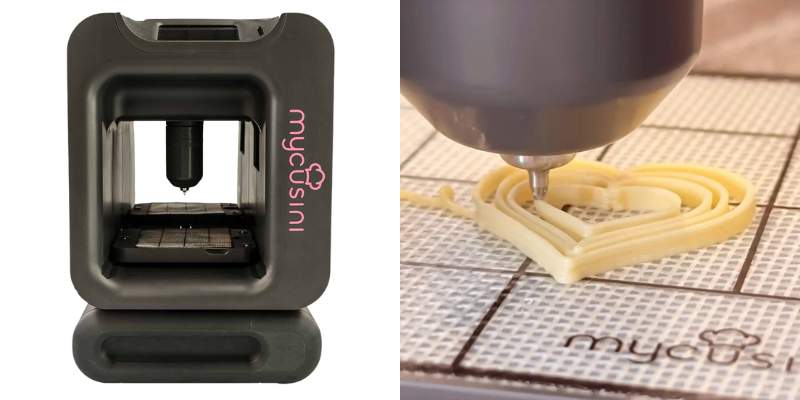
Unlike the ZMorph, the mycusini 2.0 is designed exclusively for food 3D printing, specifically chocolate. As one of the cheapest, most beginner-friendly chocolate 3D printers on the market, it’s the best option if you’re on a budget who want to dip your toe into the world of 3D printed confectionary.
Unfortunately, the mycusini is only compatible with the chocolate cartridges that they themselves manufacture and sell. This means you won’t be able to print with third party or otherwise distinctive flavors and materials like Nutella, marzipan, or cookie dough like the ZMoprh Fab can.
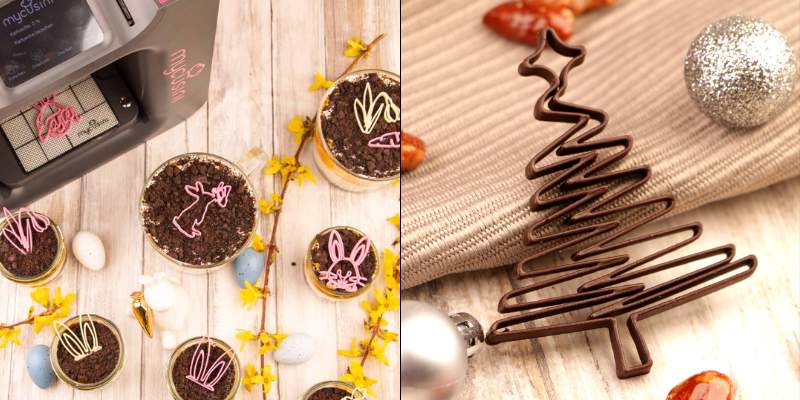
However, if you’re looking to 3D print chocolate alone, then the mycusini’s quality for its price is very hard to beat. There are four different packages to choose from, each with their own accessories and cartridges included, but the base machine you get is exactly the same, so you can choose whichever package is right for your budget and needs.
To find out more about what each package offers, you can check out the mycusini online store here, and check out how it works here.
2. Cocoa Press
- Price: starts at $1,499.00 / Pro Version starts at $3,995
- Build volume: 140 x 150 x 150mm
- Speed: Each chocolate takes between 5 minutes and 2 hours, depending on the size and complexity
- Chocolate materials it can print: Dark, milk, and white chocolate ‘Cocoa Cores’ by Cocoa Press.
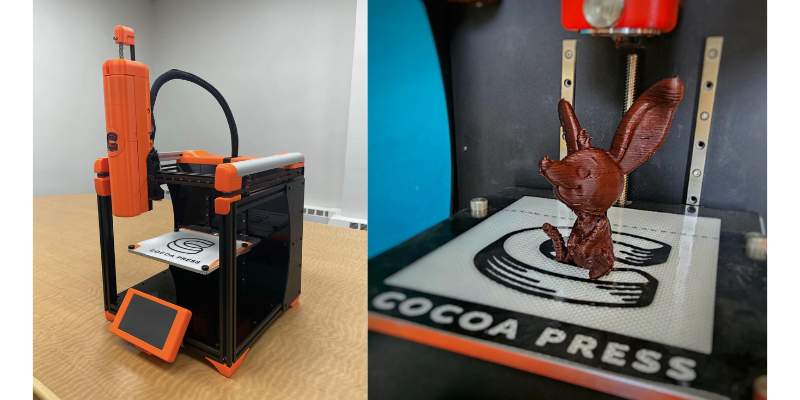
The Cocoa Press started off as a hobby for inventor Ellie Weinstein in high school, and has since become one of the best chocolate 3D printers on the market today.
The extrusion has been likened to that of a high-quality 3D printer, with excellent leveling and the creations taste so good that you’ll not feel too bad about destroying the works of art you’ve printed.
The only issue with the Cocoa Press is the fact that the much cheaper kit version requires you to have access to a standard plastic 3D printer as well as some engineering experience. This is because the kit needs extra parts that must be 3D printed by you to make the Cocoa Press work as intended.
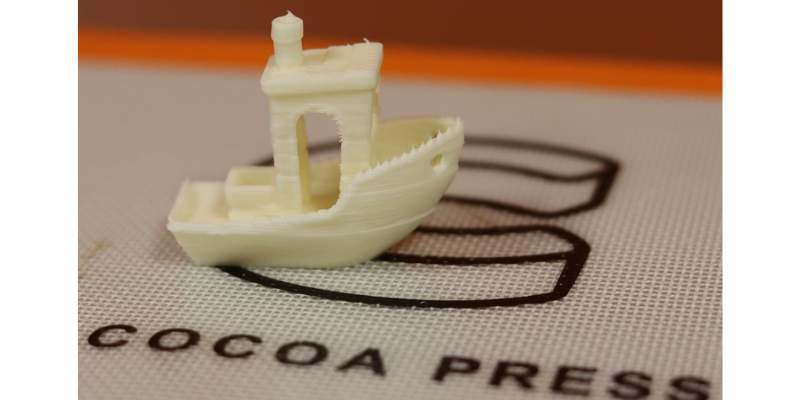
For an extra $200, you can buy these extra parts pre-made, but you will still need some engineering know-how and a soldering iron to attach them.
The Pro version comes fully assembled and with an extended warranty, but at a much higher cost. So unfortunately the Cocoa Press isn’t very accessible to people on a budget who don’t have the required prior experience. You can see 3D Printing Nerd’s reaction to it in action recently here.
Much like the mycuisini 2.0, the Cocoa Press is only designed for chocolate 3D printing, and is only compatible with the cartridges made and sold by the company itself. So if you’re looking to 3D print more complex and varied foodstuffs, then it may not be the machine for you.
3. Procusini 3D printer
- Price: Mini – $930+ / Choco – $2775+ / Chocolate – $3240+ / Research – $3700+
- Build volume: 90 x 90 x 46mm / 300 x 500 x 100mm / 300 x 500 x 100mm / 300 x 500 x 100mm
- Print speed: 1 – 2 small confectionaries per minute on average
- Food it can print: Chocolate
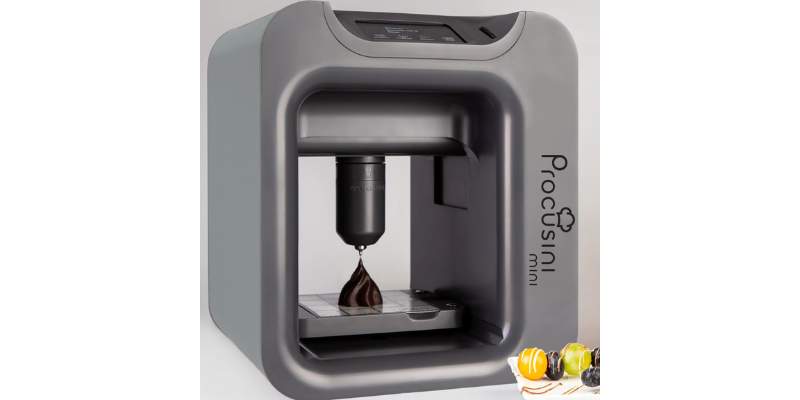
The Procusini range of food 3D printers are a versatile group of machines designed for professional applications rather than home use. This includes hotels, restaurants, catering services, and even cafés and small bakeries.
Of the four models, the most suitable for your needs depends on the scope of your business. Mom-and-pop cafés and bakeries will benefit from the small, relatively cheap Mini Procusini, while large catering services and hotels will nee the Chocolate or Research machines to provide adequate output.
While the main focus of the Procusini line is chocolate, it is much more versatile than it appears, capable of printing any paste-like foods such as marzipan and fondant. And despite its impressive power and capabilities, it’s actually very simple to set up and use as you can see in the video above. So as long as you’ve got at least some experience in 3D printing or even just 3D design, then you’ll find the any of the food 3D printers in the Procusini line very simple to use.
To decide which of the machines would be better for your business, you can check out the handy tab
4. Katjes Magic Candy Factory
- Price: Unknown
- Print speed: 5 minutes per 10 grams
- Food it can print: Vegan gummy candies in a variety of flavors
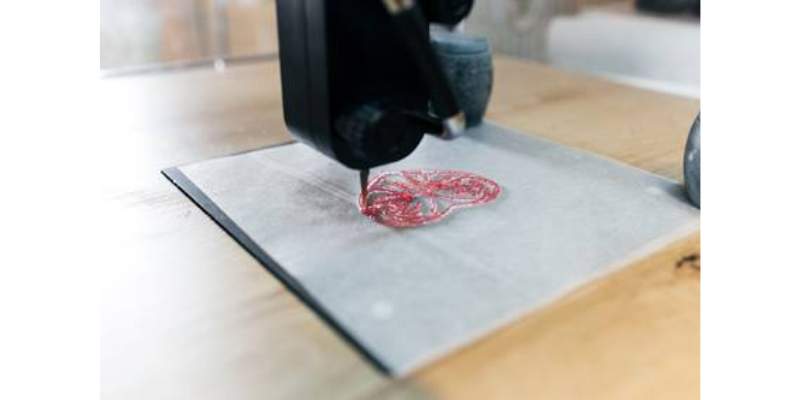
Ending with something a little more outside the box, Katjes Magic Candy Factory is a UK-based company that found success through popular investment program Dragon’s Den. Unlike the other printers we’ve looked at so far, Katjes Magic Candy Factory is not a consumer good, but rather an entertainment experience for private and social events, similar to a photo booth or catering service for parties.
Katjes Magic Candy factory takes a photo or personalized message and prints it using a recipe for vegan gummies that you can eat at your leisure. You can even use their design application service to get your own unique pictures and designs printed in this candy to make any event feel more special and personal, or choose from over 100 pre-set designs.
These candies can be eaten by anyone, as they are all vegan, gluten-free, dairy-free, and made with natural ingredients and real fruit. It uses standard FDM printing to heat up the ingredients to form a filament-like mold that can then be extruded to match the picture or design fed to the machine itself at an incredibly fast speed.
Unfortunately, the exact printing process of Katjes Magic Candy factory, including technical specs, is understandably kept quite close to the chest, so the exact nature of the printer is a secret even to us.
5. WiiBoox Sweetin — Food 3D Printer For Kids
- Cost: Check latest price at Amazon here
- Maximum food printing area: 90 x 90 x 70 mm
- Food 3D printing speed: 15 – 70 mm/s
- Accuracy: 100 microns
- Printable materials: dark chocolate, white chocolate, mashed potato, fruit jam, biscuits, white bean paste, cream candy, and purple potato mud.
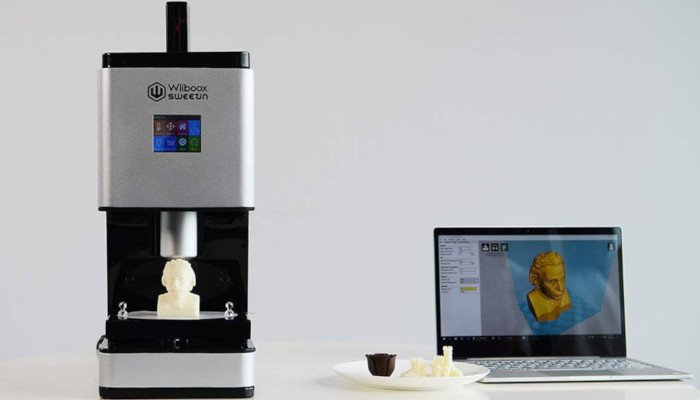
Pros
Easy to operate.
Accurate and precise.
Low-cost for a food 3D printer.
Cons
Small food printing area.
The WiiBoox Sweetin is sold as the easy to operate, accessible food printer perfect for families at home together. The printer itself comes with a number of models to print out, and you’re free to unleash your creativity by designing or downloading your own STL files to print. It’s super simple to use: just load your design onto the supplied USB and print away!
The WiiBoox 3D food printer works by preheating the chocolate filament packs (or other food filament type), setting the temperature and speed you want to print at, and then it’s ready to start! You can change the print speed based on how accurate you want your 3D printed chocolate piece to be. Comments on Amazon recommend that you leave any 3D printed chocolate model for at least 10 minutes before removing it however to ensure it has cooled down and solidified.
The WiiBoox Sweetin is accurate with 100 micron precision so any cakes you decorate or chocolate food you 3D print will look crisp and smooth. Unlike some of the other food 3D printers on this list, the WiiBoox Sweetin appears to only use a 0.6mm diameter nozzle, and though it comes with their own 3D slicer you can also set it up to use Cura.
Overall, it’s a low price food 3D printer with good reliability and is easy to use. We recommend it as a great food 3D printer for kids and families to enjoy spending time together cooking and having fun, and creating delicious chocolates and sweets at the same time.
6. FoodBot S2
- Price: $2,100 — Available on 3DPrintersOnlineStore here
- Max print volume: 150 x 150 x 73 mm
- Food print speed: 15 – 70 mm/s
- Accuracy: 100 microns
- Printable materials: biscuit, chocolate, cheese, jam, mashed potatoes, creamy candy, mung-bean paste
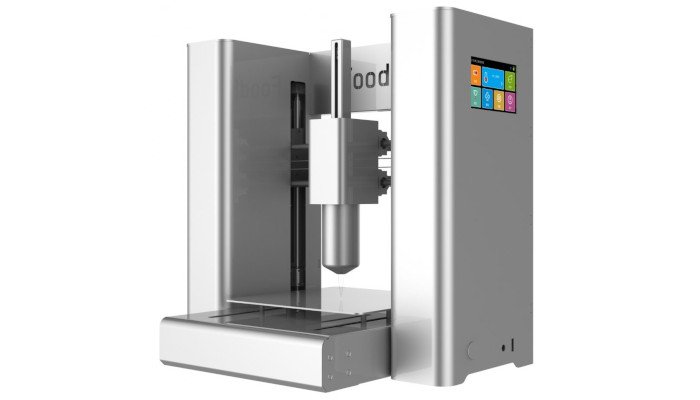
Pros
Versatile.
Changeable speeds based on the accuracy and intricacy of your print.
Ability to use nozzles ranging from 0.3 to 1.5mm based on your needs.
5.2 inch touchscreen and sleek UI add to the atmosphere.
Cons
Can fail from time to time.
A versatile food 3D printer, the FoodBot S2 can print chocolate, biscuit, jam, cheese, mashed potatoes, toffee and more! You can change the speed between 15 and 70 mm/s based on the accuracy and intricacy of your print, and alter the temperature based on your preferences.
What stands out however is how great the printer itself looks — if Apple ever made a 3D printer, this is how I imagine it would look. The design is futuristic, elegant and modern; it really adds a sci-fi feel to any kitchen. The 5.2 inch touchscreen and sleek UI add to this atmosphere.
As for accuracy, you’ll have no problem creating detailed food 3D prints with its 100 micron precision, with the ability to use nozzles ranging from 0.3 to 1.5 mm based on your needs. It comes with its own free 3D software to slice and prepare prints, and prints via either USB or SD card.
FoodBot stress how hygienic their S2 food printer is. The actual food filament never touches the printer, as it comes in disposable plastic dispenser tubes and is extruded straight through the nozzle. This makes keeping the printer clean and safe very easy, as there are no innards to clean, just the nozzle.
Overall, it’s an impressive and easy to use food 3D printer with a wide variety of materials and uses. You can see more photos of it in action on the FoodBot Facebook page.
7. Zmorph Fab
- Price: $4,700
- Build volume: 235 x 250 x 165mm
- Print speed: 40mm/s
- Food it can print: Medium – dense pastes such as marzipan, frosting, chocolate spreads, and cookie dough.
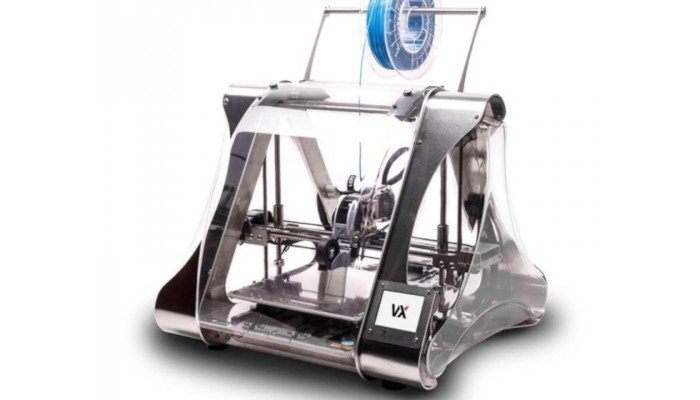
Pros
Reliable, tough and gritty.
Known for being unbelievably versatile.
Good layer resolution and excellent stability.
Cons
Zmorph do not certify that the printer’s food prints are edible or take any accountability for that.
The ZMorph Fab is a 5-in-1 machine designed for 3D printing with single and dual extruders, CNC milling, and laser engraving.
But…a lesser-known function is its ability to 3D print thick, edible pastes to make unique and complex confectionary and foods. These pastes can be anything from moderate to dense substances, making it ideal for frosting, Nutella, and even marzipan.
It sounds complicated, but ZMoprh have made it simple enough that anyone with experience in 3D printing should have to issue 3D printing edible delights. Since the paste extrusion is a separate function, there are specific settings for optimal food 3D printing, and choosing your design is no different than 3D printing standard filaments like PLA.
The main thing to note is that food printing is just one of the many uses the ZMoprh Fab offers, so if you’re only looking for a machine to 3D print food or chocolate, it’s more expensive than other options.
8. Mmuse Delta Food 3D Printer
- Price: $1,655 — Available on 3DPrintersOnlineStore here
- Maximum print volume: 100 x 100 x 100 mm
- Speed: 150 – 300 mm/s
- Printable materials: Sauce (pancake/tomato/chocolate/salad)
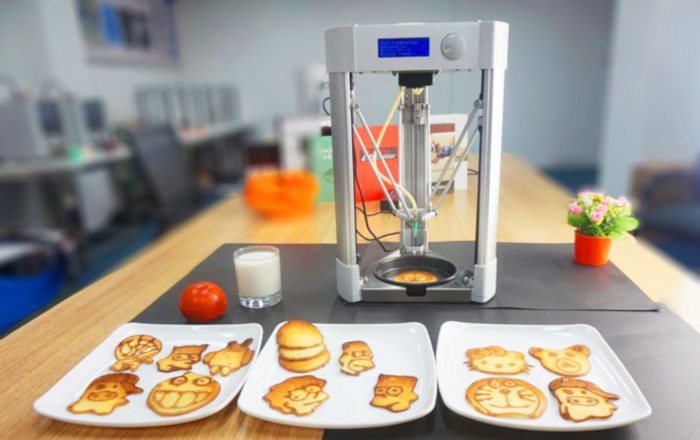
Pros
High printing speeds.
Comes fully assembled and ready to print.
Lighter than most food 3D printers.
Cons
Don’t expect pinpoint accuracy.
The only delta 3D printer on our list, the Mmuse delta brings the advantages of high printing speeds associated with these types of 3D printer to the food sector. Whereas some other food printers max out at around 70 mm/s, Mmuse claim the delta food 3D printer can print between 150 and 300 mm/s — depending on the quality of print and type.
It can print materials including chocolate, pancake, candy and tomato sauce, so you have the option of either sweet or savory. Unlike most delta printers it isn’t a DIY 3D printer, instead coming fully assembled and ready to print — saving time and effort. It’s also lighter than most of the other food 3D printers, at a very manageable 5kg.
Rather than offer a wide variety of nozzle sizes, the Mmuse delta sticks with the standard FDM 3D printer nozzle diameter of 0.4mm. It’s more of a fun food 3D printer for kids to enjoy and play with than an industrial food printer for restaurants. Don’t expect pinpoint accuracy and Michelin-level food presentation, but you can definitely still enjoy creating fun food prints of your favorite kids’ TV characters and other fun 3D printed food projects.
9. Foodbot D2 — Dual extruder food 3D printer
- Price: $6,999 — Available on 3DPrintersOnlineStore here
- Maximum print volume: 80 x 150 x 100 mm
- Print speed: 25 – 50 mm/s
- Precision: 100 microns
- Printable materials: Chocolate, biscuits, bean paste, purple potato cream, creamy candy, jam, and mashed potatoes
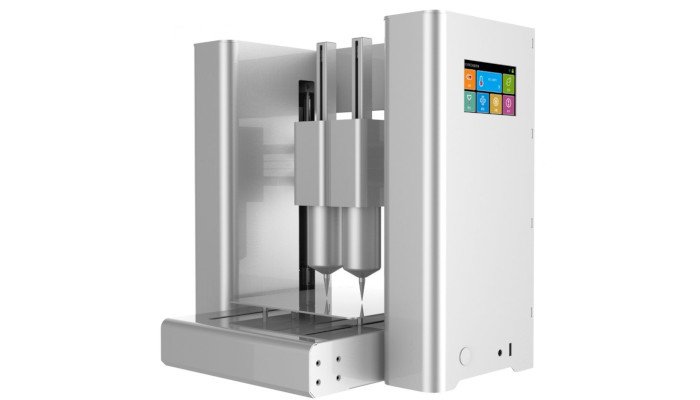
Pros
Can print two materials concurrently.
The 3.5 inch touchscreen and ergonomic UX make food printing a breeze.
Have solid, sheet metal frames which aid stability, accuracy and precision.
Cons
Pretty expensive.
An upgrade on the Foodbot S2 that also features in our ranking, this extraordinary machine not only can print intricate food structures, but can print them with two materials concurrently!
The dual heads mean you can print either two different colors of the same food material, or two different materials. So you could create your own design in part toffee and part chocolate, or any other combination you want. Additionally, the 3.5 inch touchscreen and ergonomic UX makes food printing a breeze. Here’s a video of it in action on their Facebook.
This second print head is very useful in commercial business opportunities such as creating custom edible brand logos that need to be in two different colors or materials. Custom cake decorations, intricate chocolate pieces, mini portrait pieces and busts, and general personalized gifts are made easy with the Foodbot D2.
Both the D2 and S2 food printers have solid, sheet metal frames which aid stability, accuracy and precision food 3D printing. The D2 prints at between 25 and 50 mm/s dependent on the material printed, and can be converted to use nozzles varying from 0.4mm to 1.5mm. It’s heavier however, at around 25kg — so keep this in mind if you need something very portable.
10. Mmuse Touchscreen
- Food 3D printer price: $5,700 — Available on 3DPrintersOnlineStore here
- Print volume: 160 x 120 x 150 mm
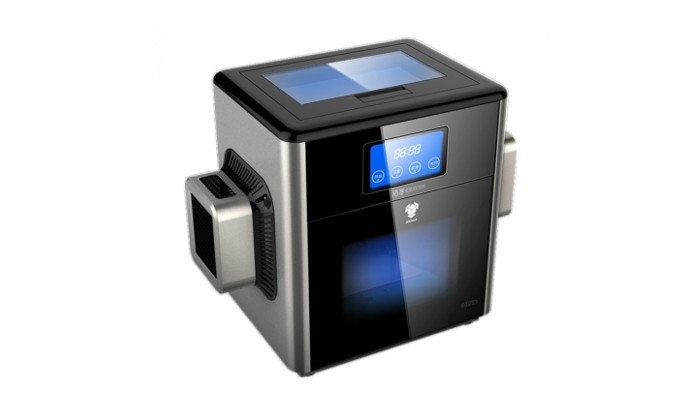
Pros
Futuristic and beautiful.
Fast speeds of between 30 and 60 mm/s.
Can print via WiFi, USB or SD card.
Comes fully assembled.
Cons
High price.
Another chocolate 3D printer, the Mmuse is a food 3D printer that looks like something out of the matrix. It’s futuristic and beautiful, selling itself as a chocolate making experience, not just a 3D printer. It’s fast too, able to print between 30 and 60 mm/s of delicious 3D printed chocolate.
There’s a reason for the high price. The Mmuse chocolate 3D printer is designed to be as convenient as possible to operate, so you can 3D print food via WiFi, USB or SD card. The beautiful touchscreen on the Mmuse makes printing a breeze, and features a strong aluminium shell. Mmuse also claim it utilizes an ‘intelligent temperature control technology’, allowing it to 3D print chocolate at the perfect temperature so the chocolate prints as smoothly and evenly as possible. Additionally, Mmuse have designed the printer nozzle to be as easy to clean and replace as possible to maintain hygiene over years of printing.
It comes fully assembled, so all you need to do is get hold of the chocolate bean filament, choose the print settings you prefer, and let it print away. The easy-to-use touchscreen makes delicious chocolate printing a pleasant experience. If you’ve got the money and you love chocolate enough, this may be the one for you. Also, if you’re a chocolatier and want to automate some aspects of production, this could be perfect.
11. Natural Machines Foodini
- Price: Only available for rental, $580 per month
- Print volume: 250 x 165 x 120 mm
- Printable ingredients: allows you to use your own real, natural, fresh ingredients for almost any food
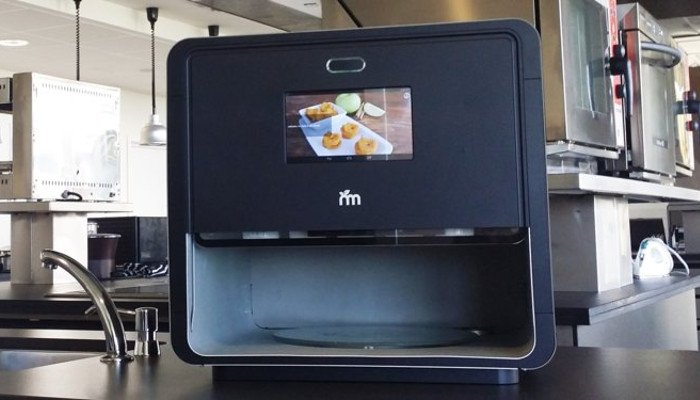
Pros
Created to streamline the repetitive tasks which are time consuming and difficult to do by hand.
A versatile food 3D printer.
Very advanced.
Cons
Not suited for beginners.
One of the most well-known food 3D printers out there, the Foodini is a food 3D printer breaking barriers left, right and center in the foodtech sector. Foodini, made by Spanish firm Natural Machines, recognize that though cooking is an enjoyable process for many, there are many tasks that could be automated. The Foodini food 3D printer was therefore created to streamline the repetitive tasks which are time consuming and difficult to do by hand.
Foodini is a versatile food 3D printer, able to print pizza, spaghetti, and even burgers. Its glowing reviews led to fairly wide use in restaurants, like the byFlow Focus has similarly achieved. Restaurants which use the Foodini include London’s Food Ink restaurant, the entirely 3D printed restaurant, as well as La Endeca at Hotel Arts, in Barcelona.
Overall, the price is steep, but this is because of how advanced the Foodini is. It’s less of a cooking tool for use within homes and more of an industrial tool for professional kitchens, but this doesn’t make it any less of an incredible foodtech achievement.
What is a Food 3D Printer?
Typical FDM 3D printing involves a 3D printer’s extruder depositing melted plastic filament along the dimensions specified in the STL file. It’s somewhat similar to icing a cake in that regard, but when you’ve completed one layer the next layer is then deposited on top of that existing layer.
3D printed food will have a layered appearance as FDM parts do — if you look hard you’ll see the tiny layers at slightly jagged angles like the steps on a pyramid, or a spring being pressed together.
With the icing a cake analogy, now assume that instead of icing, you can do the same action but with any edible food type. Chocolate, toffee, sugar, jam and savory flavors like tomato sauce / paste and cheese. Instead of being limited in the shapes you can make by the type of cake tin you use, you can now create incredibly intricate structures by perfectly depositing each part of food exactly where it is supposed to be.
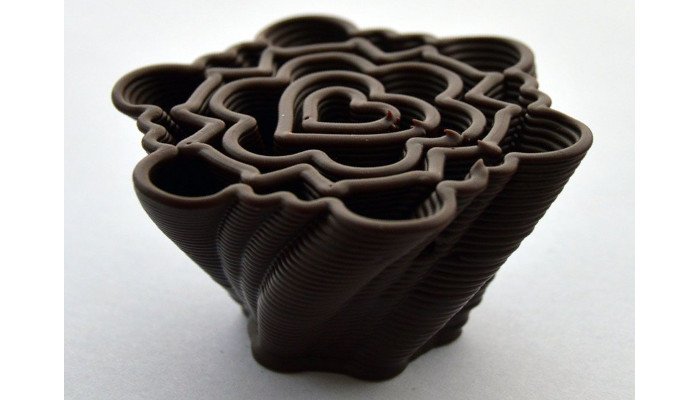
Food 3D printers are similar to FDM 3D printers — one printer on our list is a modified FDM printer — they deposit food instead of plastic filament in exactly the same way. This allows them to be more precise and accurate that any human could be, and also means that menial food jobs in restaurants and kitchens can be automated, saving time and energy.
What’s more, since you only extrude the exact amount of food you need, this makes for more efficient use of food, saving both money and the environment! This is a key and reoccurring theme in additive manufacturing.
Food 3D printers are gradually making their way into STEM education as a novel and fun new way of teaching both 3D printing skills and about what we eat. Food 3D printers for kids are also a great way of family bonding while creating something delicious to eat after, as well as by small businesses who want a new way of creating custom, up-market chocolates and other treats.
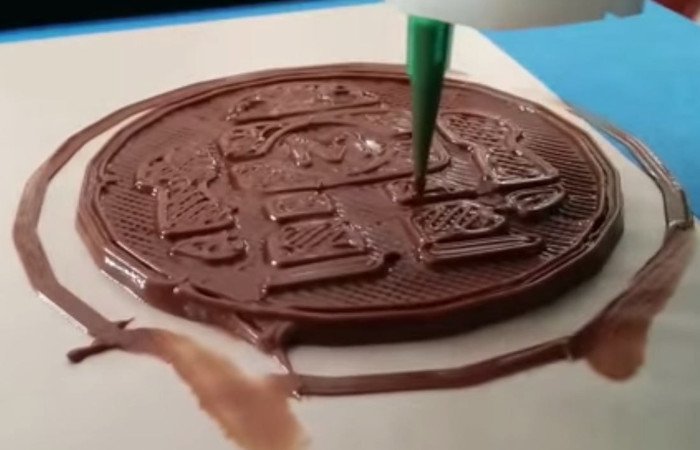
Benefits of a 3D Food Printers
- Better for the environment. 3D printed food materials can be created from alternative proteins like algae, leaves, and even insects, which are ground into a paste ready to be 3D printed. These ingredients otherwise would not be used, and are a form of protein and nutrients which may be key to future diets.
- Increased food customization. Though everybody’s food is already arguably customized, it isn’t to the level that food 3D printers offer. Not only can you create and pick the exact ingredients you want, but you can also create custom shapes and geographies that you want your food to occupy. Want a rabbit-shaped chocolate bar? Or an emoji-shaped burger? Easy. 3D printers conquer conquer the first three dimensions for you, saving you the fourth dimension — time.
- Saves time & stress. 3D food printers can automate the boring and repetitive kitchen tasks for you so you don’t need to do them. Simple tasks such as presentation and laying out of ingredients can be done by the food printer, and if you are creating food from pastes then you don’t need to chop those ingredients up yourself.
More food related articles:
- We’ve also written a feature story on 3D printed food.
- We also have a more specific ranking on the best chocolate 3D printers.





